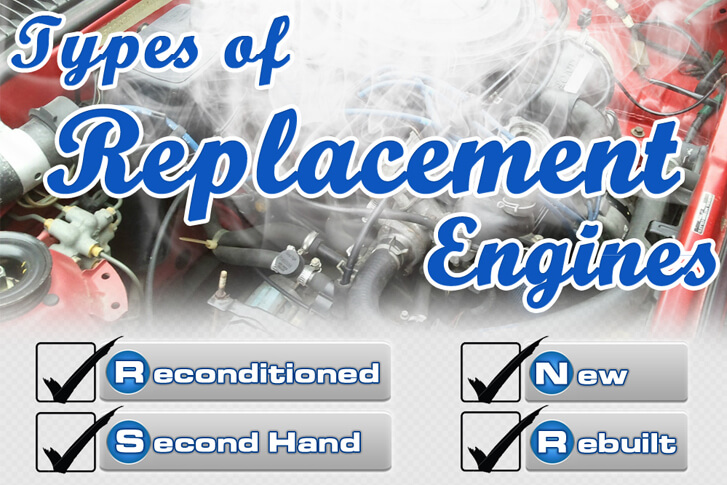
After-market car engines have different names like used, reconditioned, rebuilt or new. The need to compare these types came up after our customers asked us questions on how to differentiate between all these engine types.
A customer sent us a question that she was looking to buy a remanufactured car engine, but she thought there wasn’t a big difference between remanufactured and rebuilt engines. She wanted to know if these two are different because she found big price differences between these engine types.
Even after extensive research, one may not find any big differences between various engine types, but this article and infographic will show how these engines are different from each other and hopefully give a better picture.
Click the Image to view in higher resolution (This image is free to be used anyehere)
Remanufacturing an engine is a precise and challenging process of engine repairing. In the engine remanufacturing, reconditioning or re-engineering process the entire engine is disassembled and thoroughly cleaned for any dirty particles, grease and oil. It includes cleaning the entire engine including crankshaft, engine block, pistons, connecting rods and every other part such as the bearings.
In the second phase, all engine parts are tested for defects. Slightly worn parts are repaired and defected parts are replaced with new ones if they are beyond repairing process. New parts like pistons, connecting rods, piston rings, crankshaft bearings, camshafts and their bearings, oil pump and gaskets are installed in the engine. All flat bearing surfaces are refurbished along with other worn surfaces.
The third and final phase starts with reassembling and testing. In this phase, engineers use state of the art technology and automated equipment to inspect every part and assemble it.
Generally in remanufactured engines, engineers revamp mechanical tolerances and clearances by machining and restoring the surfaces with necessary fillings up to the original mechanical standards for OEM. The entire engine is checked and tested for durability and reliability. These same procedures apply to the other engine parts if necessary and it is the main reason why remanufactured engines usually carry higher prices and a longer warranty than rebuilt engines.
The inspection process makes sure that the remanufactured engine part must comply with the manufacturing standards of that particular brand. If it is a Ford Transit engine under process, it must meet certain performance requirements set by Ford Motor Company.
Engineers use different techniques to test the performance including vacuum testing and compression testing. A re-engineered engine is closest to being a new engine.
Rebuilt engine is not like remanufactured engine as it is partially disassembled or inspected for defects that are unelectable. Let’s look at an example to understand the difference.
If your BMW N47 engine is subjected to remanufacturing process it means it uses new pistons, new rings, new gaskets and new cylinder linings with polished crankshaft etc. A rebuilt engine will only use new piston rings if necessary for refined performance and boosted compression. If they are in useable condition, they will be used again without any further treatment.
A rebuilt engine usually has very short or even no warranty period. Engineers disassemble the engine to clean, test, conduct initial tests and replace only broken or seriously worn parts with used parts from any other engine. After inspection, engines are rebuilt for using again and serviceable parts are used if they pass initial test. The quality of rebuilt engine varies from mechanic to mechanic.
Keep in mind that rebuilt engine comes in good working condition and components that are not replaced may work properly. There are several other factors that might cause wear like cracks and heat stresses. Consequently, these factors cause other problems after some time and can cause a premature failure in any engine part.
Overall this technique saves you a lot of money, but a rebuilt engine can stop working more often compared to a reconditioned engine.
A brand new engine is exactly that crate engine, a new unused engine with no miles whatsoever and they are normally only available from main dealers. The cost can be very high making the repair extremely expensive. A new engine can sometimes cost more than their vehicle price.
New engine prices are normally around £4000 – £12000 mark depending on make and model for your average vehicle and can be as much as £75000 for more exotic cars.
A used engine is one that has been taken from another vehicle to reuse in the same kind of vehicle. These engines are usually resourced from damaged vehicles or from an insurance write off. Mileages can vary from newer cars with little or no mileage to older cars with hundreds of thousands plus in miles on the engine.
Second hand or used engines can come with more items attached such as manifolds, injectors, etc. but it is still recommended to use your original components as one cannot guarantee working condition of these parts. In most circumstances, parts left on the engine do not carry any warranty.


